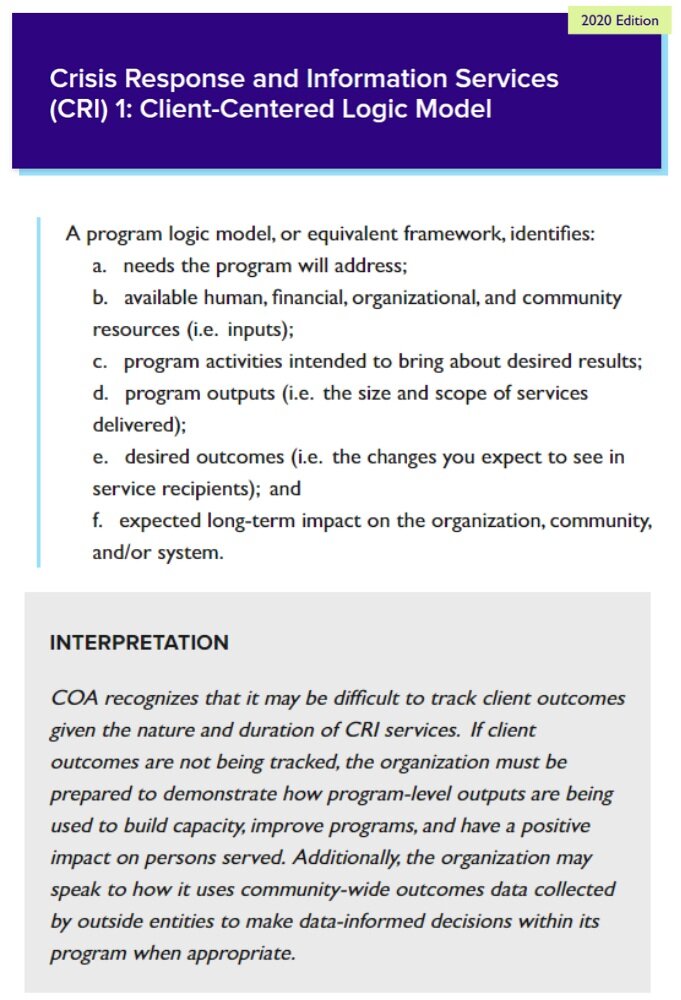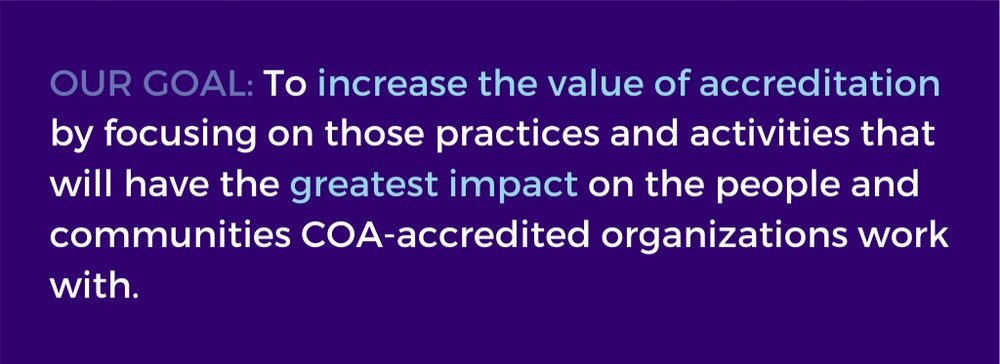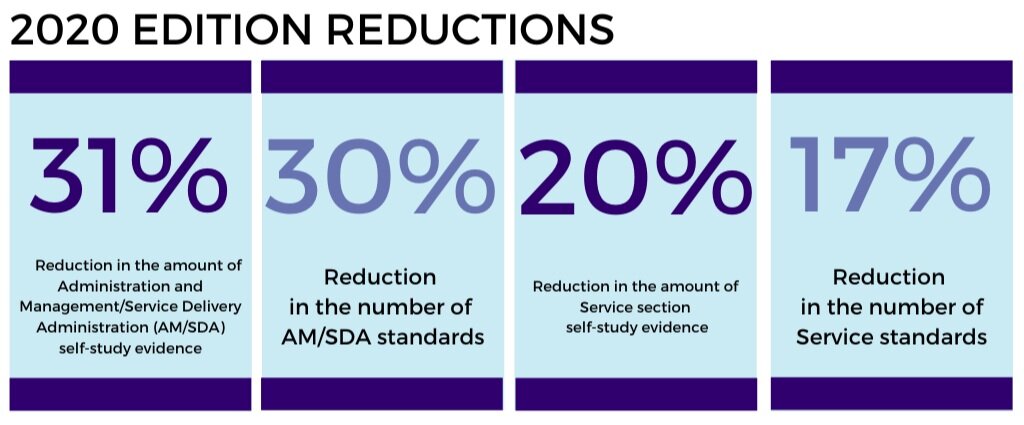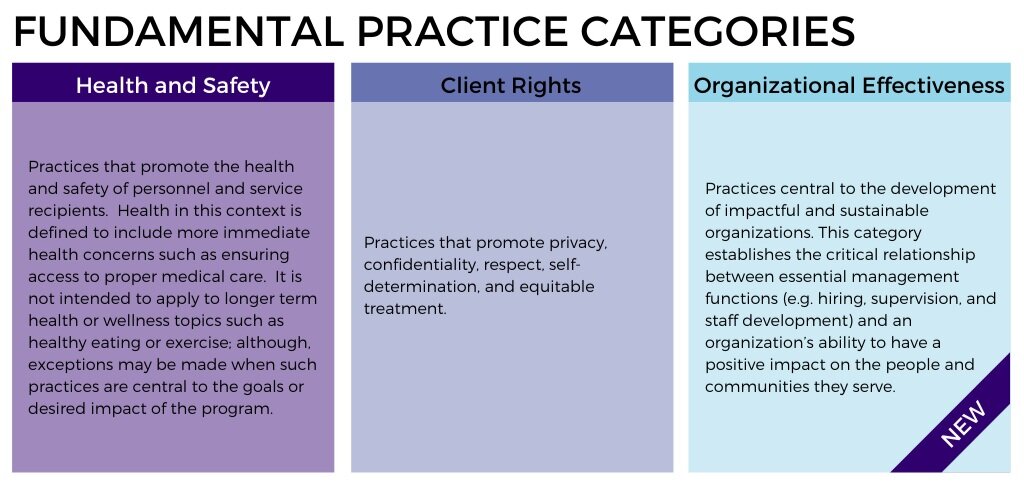This is Part II of a series on the thinking behind the Council on Accreditation (COA)’s 2020 Edition updates. Visit Part I here.
As we mentioned in Part I of this series, the goal of the COA 2020 Edition Standards is to promote the development of effective, mission-driven organizations that are equipped to meet the needs of their clients. Strategic planning is the vehicle by which an organization can move towards closing the gap between where they want to be (their mission) and where they are today.
That is why we have introduced a new Core Concept standard on Logic Models into every service section of the 2020 Standards. These will guide organizations to think systematically about the client outcomes they hope to achieve, the ultimate impact each of their programs is intended to have, and how the program will utilize its assets and resources to achieve its goals.
Below are answers to some commonly asked questions about the new Client-Centered Logic Model Core Concept.
Q: Why did COA strengthen our standards for program logic models?
A: In order to achieve something, you first need to define what you are trying to achieve! Funders are already asking organizations to demonstrate how they are achieving their mission, as well as what impact their programs have on the people they serve. Completing a program logic model is a proven method for identifying how a program will use its assets, resources, and program activities to promote desired outcomes and have its intended effect.
Quality improvement is one of the aspects of COA accreditation that presents a challenge for organizations. It is also one of those that has the biggest impact. A logic model, or an equivalent framework, concisely demonstrates an organization’s quality improvement efforts at the program level.
Q: Why is COA creating a greater focus on outcomes?
A: Once you know what you want to achieve and how you will do it, you then need to measure your success. It is essential for organizations to demonstrate their program’s effectiveness through the use of data. Measuring outcomes is one mechanism to do this, as it helps determine the level of performance or achievement that occurred over time because of the services provided (i.e. how services are changing the lives of their service recipients).
This is why it’s important to define and measure outcomes. Without knowing the intended result, it becomes difficult to demonstrate the true impact of the services provided.
In many ways, outcomes represent the hallmark of service provision; they help an organization articulate why someone should come to this organization for services. Outcomes data can also help organizations make informed decisions about their resource needs and how those resources should be allocated in order to sustain positive change.
Q: Is COA rating organizations on whether or not they achieve the intended outcomes?
A: No, we are not rating an organization on the success of their outcomes. Instead, we look at: 1) an organization’s implementation of a framework for defining their success, 2) how they measure that achievement, and 3) what changes they make based on that data. The logic model is intended to support programs–and ultimately the organization–by providing organizations with a tool to demonstrate to themselves, their communities, and their funders that their programs are producing the desired impact.
Q: What is the difference between an outcome and output?
A: Outcomes indicate a change over time as a result of an active intervention. Within the context of programs, outcomes represent what the program expects services recipients to leave with (e.g. improved quality of life; decreased depressive symptoms, etc.). Outcomes answer questions such as: has the service recipient’s behavior improved? Have parenting skills improved? Has knowledge been gained in a particular subject?
Outputs state what was produced or activities conducted. Outputs quantify the activities and should always be connected to a numerical value. Examples of outputs include: number of visits made, number of people served, number of counseling sessions.
Note: Due to the nature of some services it is difficult to measure outcomes over time, so the standards are slightly different. For example, Crisis Response and Information Services (CRI) only includes one standard regarding the logic model as well as an interpretation.

Here at COA, we are optimistic about how the implementation of logic models can help organizations blaze new paths toward improved service delivery and outcomes. By starting with the end in mind, we in the human and social services field can focus on what matters most and has the greatest impact.
Have an unanswered logic model question? Send us an email!
For more information on the changes in the 2020 Edition and who they affect, download our overview here. Accredited and in-process organizations can also access two recorded webinars with in-depth information in their MyCOA portal (under the tools tab). If you are new to COA and have questions about the standards or process changes, feel free to contact us!
This is Part I of a series on the Council on Accreditation (COA)’s 2020 Edition updates. Visit Part II here.
On January 15, 2020, we released an enhanced and refined set of private, public, and Canadian standards on our website. All of the work was done with a single goal in mind: to increase the value of accreditation by focusing on those practices and activities that will have the greatest impact on the people and communities COA-accredited organizations work with.

Our approach to the work
The COA 2020 Edition was the culmination of a review of the literature on organizational effectiveness and valuable feedback from our volunteers, organizations, and partners who provided critical insight into which aspects of COA’s accreditation process and standards were impactful to organizations and their clients, and which were not.
Our mission at COA is to partner with human and social service organizations to strengthen their ability to improve the lives of the people they serve. Our belief is that in order to have the greatest impact on clients, the entire organization—from Human Resources to Finance to those directly delivering services and beyond—must be working together to fulfill that organization’s mission. COA’s 2020 Edition was designed to highlight and strengthen that connection.
Refocusing the Self-Study process
In service of focusing accreditation on the standards that promote the development of effective, mission-driven organizations that are equipped to meet the needs of their clients over time, we have refined the standards to:
1. Give organizations more time to devote to those practices that have a more direct impact on clients, and
2. Allow organizations to spend less time compiling evidence and more time improving practice.
This is reflected in the 2020 Edition in multiple ways.
Firstly, in the years of work leading up to the 2020 Edition Standards launch, we sought to tighten what we ask of organizations. We eliminated or combined redundant standards within and across sections. We reorganized similar content whenever possible, and we eliminated overlap with state and government regulation.
We also sought to clarify expectations and delete what wasn’t needed. One way this was accomplished was by minimizing Interpretations within the standards including converting those that were informational in nature and not required into “Examples,” deleting those that were unnecessary or outdated, merging required interpretive language into the standard whenever possible, and adopting naming conventions to clarify when Interpretations only apply to specific service types (e.g. FEC Interpretation). Another was by moving research notes out of the standards and into the Reference List for each section.
Finally, we made a concerted effort to alleviate evidence pain points identified by our organizations and volunteers. This included:
- Deleting all narratives in both the AM/SDA sections and the Service sections
- Deleting requests for “descriptions of services” from the self-study evidence
- Minimizing requests for meeting minutes and clarifying the quantity that is needed when appropriate
- Standardizing how we ask for training documentation
- Standardizing how we ask for information on caseload or workload
- Removing requests for documentation of legal compliance
- Eliminating Data Sheets from the service sections except where they may be provided as an optional resource for reporting information when desired
- Eliminating redundant evidence or documentation requests from across the various stages of the accreditation process
This all means that organizations seeking reaccreditation will see significant reductions in the volume of requested evidence. It is our intention that the staff time and resources gained from these reductions can be redirected to the practices that have the most impact on the individuals and families served.

Homing in on Administration and Management (AM) standards
With the 2020 Edition, we wanted to clarify and strengthen the connection between Administration and Management (AM) standards of practice and mission fulfillment.
With that in mind, we reviewed all five of the administration and management standards, which include Human Resources (HR), Financial Management (FIN), Performance and Quality Improvement (PQI), Risk Prevention Management (RPM), and Governance (GOV), to identify and in some instances enhance the standards and evidence that will be used to assess the role each part of an organization plays in supporting impact or achieving its mission.
For a detailed breakdown of the important role each part plays in this, download our fact sheet here.
Highlighting the most important practices
As organizations familiar with our accreditation process know, Fundamental Practice (FP) standards are those standards that an organization must meet in order to achieve accreditation. With the mission impact-focus of the 2020 Edition, we have expanded the categories of FP standards to include practices that promote organizational effectiveness. FP categories now include: Health and Safety, Client Rights, and Organizational Effectiveness.

It all comes together with strategic planning
An organization’s mission serves as the benchmark by which organizational effectiveness is measured, and strategic planning is the vehicle by which an organization can move towards closing the gap between where they want to be (their mission) and where they are today. Outcomes data coming from PQI activities, HR data coming from the annual assessment of workforce needs, and risk prevention and management activities are all examples of information that feeds into the strategic planning process. Strategic planning, in turn, informs each decision that an organization makes, from budgeting decisions to hiring and personnel development decisions, with the ultimate goal of closing its mission gap.
This is why we have introduced a new Core Concept standard on Logic Models into every service section of the 2020 Standards. These standards guide organizations to think systematically about:
- The client outcomes they hope to achieve
- The ultimate impact each of their programs is intended to have
- How the program will utilize its assets and resources to achieve its goals
In other words, we’re hoping to help organizations work smarter, not harder.
These logic models denote an exciting advancement in our standards from previous iterations. To learn more about them, check out Part II of this blog series: COA 2020 Edition | FAQs about the Logic Model.
For more information on the changes in the 2020 Edition and who they affect, download our overview here. Accredited and in-process organizations can also access two recorded webinars with in-depth information in their MyCOA portal (under the tools tab). If you are new to COA and have questions about the standards or process changes, feel free to contact us!
This year COA turns 40. To honor the occasion, here’s a timeline of key milestones that have helped define COA and its role in the human services field.

